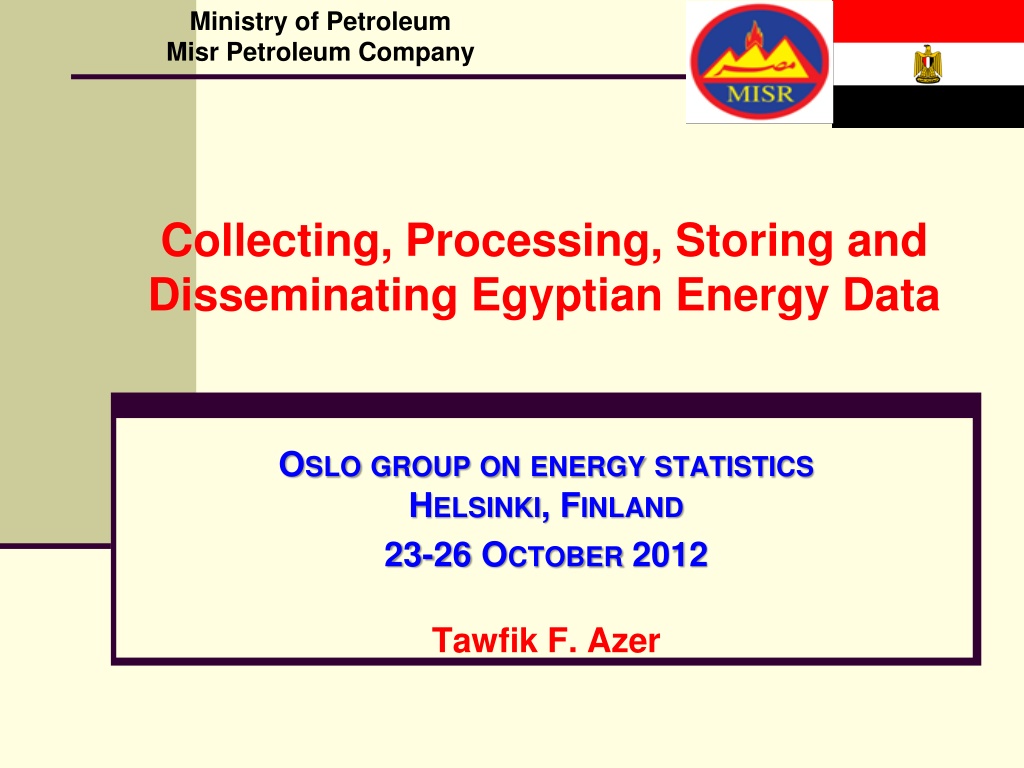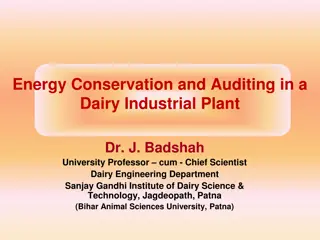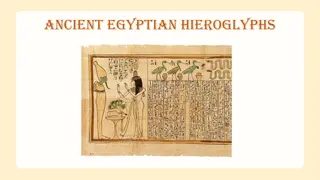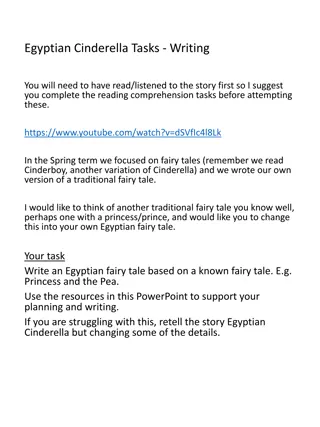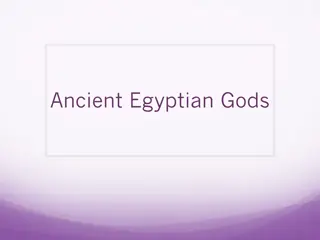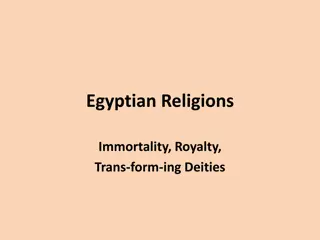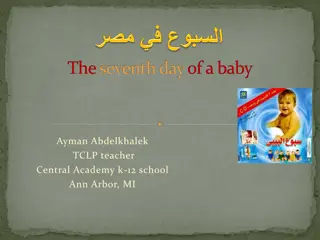Comprehensive Overview of Egyptian Energy Data Collection and Processing
This detailed document delves into the collection, processing, storage, and dissemination of energy data in Egypt, focusing on sources such as crude oil, petroleum products, natural gas, and electricity. The process involves various entities like Misr Petroleum Company, EGPC, EGAS, and EEHC, highlighting the importance of collecting primary data for accurate analysis and reporting to regional and international organizations.
Download Presentation

Please find below an Image/Link to download the presentation.
The content on the website is provided AS IS for your information and personal use only. It may not be sold, licensed, or shared on other websites without obtaining consent from the author. Download presentation by click this link. If you encounter any issues during the download, it is possible that the publisher has removed the file from their server.
E N D
Presentation Transcript
Egypt - Alternative design Egypt - Alternative design Ministry of Petroleum Misr Petroleum Company Collecting, Processing, Storing and Disseminating Egyptian Energy Data OSLO GROUP ON ENERGY STATISTICS HELSINKI, FINLAND 23-26 OCTOBER 2012 Tawfik F. Azer
Egypt - Alternative design Objective Unveiling who collects raw data, in what forms is such data available, what processes are usually applied to the data. Showing which regional / international organizations have already received energy data of the country. 2 Collecting, Processing, Storing and Disseminating Egyptian Energy Data Tawfik F. Azer
Egypt - Alternative design Contents Data on Energy Production and Consumption Data on Renewable Energy Data on Energy Efficiency Collecting Primary Data Processing Energy Data Present Transfer of Information 3 Collecting, Processing, Storing and Disseminating Egyptian Energy Data Tawfik F. Azer
Egypt - Alternative design Energy Production and Consumption Collecting Primary Data Crude Oil and Petroleum Products MOP is the main source of this data. EGPC is collecting crude oil data bottom-up from fields to companies to EGPC then to MOP. Petroleum products production data collection path is from refineries to companies then to EGPC and finally to MOP. EGPC is also collecting detailed data on petroleum products consumed by each economic sector and for each fuel type. 4 Collecting, Processing, Storing and Disseminating Egyptian Energy Data Tawfik F. Azer
Egypt - Alternative design Energy Production and Consumption Collecting Primary Data (2) Natural Gas MOP is the main source of such data. EGAS is responsible of collecting data from fields through its affiliate companies and convey it to MOP. MOP and EGAS are collecting necessary data regarding natural gas consumption pattern in Egypt. Amounts and percentages of natural gas consumed by each economic sector in the country are generally available from these entities. 5 Collecting, Processing, Storing and Disseminating Egyptian Energy Data Tawfik F. Azer
Egypt - Alternative design Energy Production and Consumption Collecting Primary Data (3) Electricity EEHC MOEE, is collecting electricity generation data from each power plant through its affiliate generation companies and private companies. MOEE and EEHC are collecting comprehensive data concerning electricity consumption for each economic sector (industry, agriculture, government, public lighting, residential and commercial). 6 Collecting, Processing, Storing and Disseminating Egyptian Energy Data Tawfik F. Azer
Egypt - Alternative design Energy Production and Consumption Present Transfer of Information to Regional and International Organizations AFREC is the only regional organization that receives energy data from Egyptian institution, namely, ENC-WEC. MEDENERused to obtain energy data from OEP. WEC, IEA and ENERDATA are regularly receiving energy data from ENC-WEC. UNSD is getting Egyptian energy data from MOP. UNSD used to have it from OEP as well. 7 Collecting, Processing, Storing and Disseminating Egyptian Energy Data Tawfik F. Azer
Egypt - Alternative design Renewable Energy Sources of Primary Data Installed Capacity and Energy Generation MOEE and NREA are the main sources of information regarding renewable installed capacity and its generated energy. EEHC and NREA afford such information; EEHC provides data through its annual reports while NREA manages this piece of information in the course of its website and annual reports. 8 Collecting, Processing, Storing and Disseminating Egyptian Energy Data Tawfik F. Azer
Egypt - Alternative design Energy Efficiency Potential Sources of Primary Data EEIGGR is a potential source of some primary data. EEIGGR has established its own Energy Efficiency Information Centre for its project's data. Sometimes EEIGGR is obtaining needed information from the manufacturers. CAPMAS and manufacturers are potential sources of primary data regarding investment, sales, imports and exports of the equipment. ESCO'S are certainly potential sources of information about the market of energy efficiency equipment. 9 Collecting, Processing, Storing and Disseminating Egyptian Energy Data Tawfik F. Azer
Egypt - Alternative design Energy Efficiency Potential Sources of Primary Data (2) Customs Authority, EEIGGR, ESCO'S and Chambers of Commerce are potential sources for similar data. Limited number of studies tackled the issue of employment impact in the field of energy efficiency. An example of such studies is "Energy Efficiency Testing Facilities of Home Appliances in Egypt which is already published over the WEB. 10 Collecting, Processing, Storing and Disseminating Egyptian Energy Data Tawfik F. Azer
Egypt - Alternative design Main Difficulties Data are not disaggregated enough. Definitions of sectors are not exactly the same among producers and consumers. Definition of transport sector was altered few years ago regarding data from EGPC. In few cases, confidentiality is an issue regarding import/export of crude oil. 11 Collecting, Processing, Storing and Disseminating Egyptian Energy Data Tawfik F. Azer
Egypt - Alternative design Main Difficulties In most cases, we have residential and commercial consumptions as one item (not disaggregated). Recently, consumption of Jet Fuel and Kerosene is combined. The same is for Naphtha and Gasoline. We obtain material balanced refineries data, these data will never be energy balanced. We put the variation as statistical difference. 12 Collecting, Processing, Storing and Disseminating Egyptian Energy Data Tawfik F. Azer
Egypt - Alternative design ENERGY BALANCE IN EGYPT 2010/2011 CONVERSION SECTOR PRIMARY ENERGY PRODUCTION 89.756 FINAL CONSUMPTION 53.179 BUNKERS IMPORTS EXPORTS 11.645 IMPORTS 2.425 EXPORT 5.784 7.708 1.317 8.435 5.070 INDUSTRY 22.853 43.6% 28.776 29.516 29.381 30.326 CRUDE OIL 28.139 31.4% 3.500 REFINERIES 1.546 St. Diff. 1.405 5.182 10.887 5.546 1.723 Stock Exchange + St. Diff TRANSPORTATION 11.269 21.5% 0.382 CONDENSATES 5.546 6.2% St. Diff. 0.915 0.792 LOSSES & OWN USE LPG 1.546 1.7% PETROLEUM EXCLUDING REFINERIES AGRICULTURE 2.656 5.1% 2.232 4.056 EXPORT 12.388 0.482 12.901 NATURAL GAS 51.455 57.3% 0.424 16.855 12.799 21.730 0.874 5.182 RESID. & COMM. 14.124 26.9% 7.953 0.102 St. Diff. 0.124 11.354 5.297 Net Export THERMAL TRANS. LOSSES 10.762 12.197 1.541 OTHERS. 2.277 2.9% 12.833 HYDRO 2.715 3.0% 0.736 (Rounded) HYDRO 0.028 St. Diff. HYDRO CONVERSION 1.593 1.122 1.283 TRANSM. & DISTRIB. LOSSES RENEWABLE0.147 RENEWABLES 0.355 0.4% RENEWABLES CONVERSION 0.208 0.425 OWN USE ELECTRICITY GENERATION HYDROPOWER IS CALCULATED AS 1 KWh THERMAL GENERATION REQUIRES 208.1 GRAM OF OIL EQUIVALENT ( THERMAL EFFICIENCY 42.1%) UNITS : MILLION TOE
Egypt - Alternative design Conclusion Many organizations manipulate primary energy data for obtaining summary tables, graphs or indicators. Few organizations are processing data for energy balance, inclusive reports or websites. MOP and EGPC are among those entities that make data processing for retrieving indicators, tables, graphs and for their databases. EGAS is managing its produced data for its annual reports as well. PICO is coping with the energy data for its own database. 14 Collecting, Processing, Storing and Disseminating Egyptian Energy Data Tawfik F. Azer
Egypt - Alternative design Conclusion (2) EEHC and NREA (MOEE) use the processed data to get indicators, summary tables and graphs to be published in their annual reports. ENC-WEC is manipulating data in different format to cope with some international energy institutions' forms. ENC-WEC also process data to acquire the country's profile and energy balance. EEIGGR works with the energy efficiency data to have summary tables and graphs to be used in presentations and technical reports. 15 Collecting, Processing, Storing and Disseminating Egyptian Energy Data Tawfik F. Azer
Egypt - Alternative design Conclusion (3) Information on energy production and consumption is regularly produced, readily available and already being transferred to a number of regional and international organizations. CAPMAS is dealing with such data to search out for some economic and energy indicators. OEP was handling these data for its comprehensive annual reports and database. Energy balance is yearly achieved by ENC-WEC. 16 Collecting, Processing, Storing and Disseminating Egyptian Energy Data Tawfik F. Azer
Egypt - Alternative design Conclusion (4) Relevant energy efficiency data is processed to get Energy Efficiency indicators by ENC-WEC. Energy efficiency strategy and policies are available as well through ENC-WEC in electronic forms. 17 Collecting, Processing, Storing and Disseminating Egyptian Energy Data Tawfik F. Azer
Egypt - Alternative design Thank you Thank you
